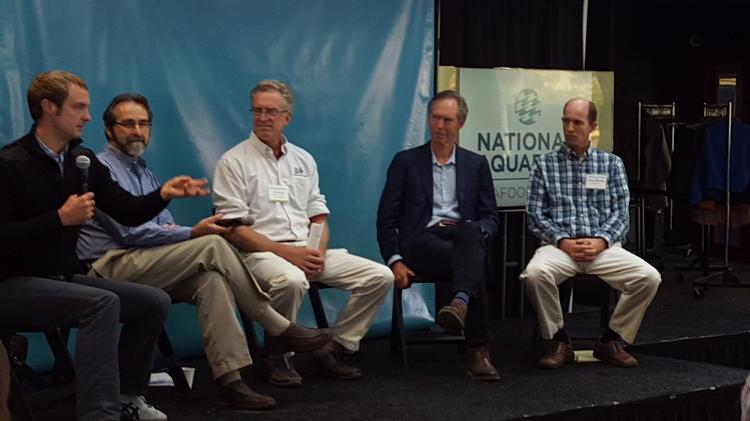Chesapeake Bay aquaculture presents as many opportunities as challenges, seafood leaders say
Jumping in on the oyster gold rush might
seem like a quick way to make a buck, but area aquaculture leaders say
creating a viable aquaculture business in the Chesapeake Bay is tougher
than it looks.
There's plenty
of room for new players in Maryland's aquaculture industry, and part of
the National Aquarium's East Coast Seafood Forum on Monday highlighted
advancements in aquaculture technology that will help the field expand.
But there are also a number of challenges associated with growing fish
and shellfish.
The biggest hurdle, particularly for small-scale fish farmers such as
Chris Bentley of Bradley Bay Farms in Quinby, Va., is growing their business to scale.
"It has been challenging as a small producer, "Bentley said during a panel discussion at the forum. "Our biggest challenge is our scale, trying into the existing seafood supply chain. Most of that supply chain you really need large volumes consistent supply."
There are several options for growing environments when it comes to aquaculture. Fish and shellfish can be grown in ponds, tanks or marine environment, although some species are better suited for particular environments.
For those species that flourish in tanks, scientists at the Institute of
Marine and Environmental Technology in downtown Baltimore are working
to develop technology that makes growing them more environmentally
sustainable.
John Stubblefield,
a researcher at the Institute of Marine and Environmental Technology,
is helping develop technology for those systems to help them use less
salt water, recycle water and eliminate waste. Growing European sea
bass, for example, generates 825 pounds of waste for every 2200 pounds
of fish, he said, and managing and storing that waste can create a real
problem in a warehouse with limited space.
Stubblefield is also working on high-density breeding to maximize the return on tank space.
"If you're going to be spending the money on tank infrastructure, you better be making some money on the back side because it's more effective," Stubblefield said
Closed-loop aquaculture systems like the ones used at the Pier V facility - which don't draw on or return to external water souces - are just coming to market, and they're still expensive. And growing fish in ponds or other marine enviornments comes with its own set of difficulties, including managing escapes and competing with other land-use and water-use interests.
Oysters have been one area where local
watermen have seen success in growing and creating sustainable
aquaculture businesses. Hooper’s Island Oyster Aquaculture Co. is one
such company that's figured out the oyster equation, and one that
co-founder John Shockley said can serve as a model for other fisheries.
Shockley spent
his life as a waterman on the Chesapeake Bay, and he helped found the
oyster farm after realizing watermen needed to rethink their harvesting
methods.
“We could not rebuild the house from the roof down,” Shockley said. “We have to figure out how to start over again.”
